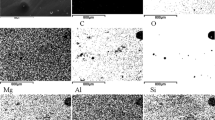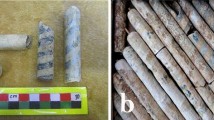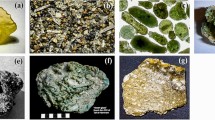Abstract
Libyan desert glass (LDG) is a melt product whose origin is still a matter of controversy. With the purpose of adding new information about this enigma, the present paper analyzes the inner part of LDG specimens and compares them with the results of LDG surfaces. An integrated analytical methodology was used combining different techniques such as Raman spectroscopy, in point-by-point and imaging modes, scanning electron microscopy with X-ray microanalysis (SEM-EDS), energy-dispersive micro X-ray fluorescence spectrometry (μ-EDXRF), electron probe micro analyzer (EPMA), and optical cathodoluminescence (Optical-CL). According to our results, flow structures of the melt and the amorphous nature of the matrix could be discerned. Moreover, the observed displacement of Raman bands, such as in the cases of quartz and zircon, and the identification of certain compounds such as coesite (the most clarifying phase of high pressures), α-cristobalite, gypsum, anhydrite, corundum, rutile, amorphous calcite, aragonite, and calcite allowed us to know that LDGs could be subjected to shock pressures between 6 and more than 30 GPa, and temperatures between 300 and 1470 °C. The differences of temperature and pressure would be provoked by different cooling processes during the impact. Besides, in most cases the minerals corresponding to high pressure and temperatures were located in the inner part of the LDGs, with some exceptions that could be explained because they were trapped subsequently to the impact; there was more than one impact or heterogeneous cooling.
Furthermore, nitrogen and oxygen gases were identified inside bubbles, which could have been introduced from the terrestrial atmosphere during the meteorite impact.
These data helped us to clarify some clues about the origin of these enigmatic samples.








Similar content being viewed by others
References
Clayton PA, Spencer LJ. Silica-glass from the Libyan Desert. Mineral Mag. 1934;23:501–8.
Pratesi G, Viti C, Cipriani C, Mellini M. Silicate-silicate liquid inmiscibility and graphite ribons in Libyan desert glass. Geochim Cosmochim Acta. 2002;66:903–11.
Swaenen M, Stefaniak EA, Frost R, Worobiec A, Van Grieken R. Investigation of inclusions trapped inside Libyan desert glass by Raman microscopy. Anal Bioanal Chem. 2010;397:2659–65.
Barrat JA, Jahn BM, Amosse J, Rocchia R, Keller F, Poupeau GR, et al. Geochemistry and origin of Libyan desert glasses. Geochim Cosmochim Acta. 1997;61:1953–9.
Koeberl C. Libyan desert glass: geochemical composition and origin. Proceedings of the “Silica '96” Meeting, Pyramids Segrate, Milano, 1997.
Schaaf P, Müller-Sohnius D. Strontium and neodymium isotopic study of Libyan desert glass: inherited Pan-African age signatures and new evidence for target material. Meteorit Planet Sci. 2002;37:565–76.
Aboud T. Libyan desert glass: has the enigma of its origin been resolved? Phys Proc. 2009;2:1425–32.
Storzer D, Wagner GA. Fission-track dating of meteorite impacts. Meteoritics. 1977;12:368–9.
Ramirez-Cardona M, El-Barkooky A, Hamdan M, Flores-Castro K, Jimenez-Martinez NI, Mendoza-Espinosa M. On the Lybian desert silica glass (LDSG) transport model from a hypothetical impact structure. International Geological Congress (IGC), Oslo. 2008, PIS-01 (abstr.).
Jimenez-Martinez N, Ramirez M, Diaz-Hernandez R, Rodriguez-Gomez G. Fluvial transport model from spatial distribution analysis of Libyan desert glass mass on the Great Sand Sea (Southwest Egypt): clues to primary glass distribution. Geosciences. 2015;5:95–116.
Horn P, Müller-Sohnius D, Schaaf P, Kleinmann B, Storzer D. Potassium–argon and fission-track dating of Libyan desert glass, and strontium- and neodymium isotope constraints on its source rocks. In: de Michele V, editor. Proc. “Silica 96”: meeting on Libyan desert glass and related events. 1997:59-76.
Greshake A, Koeberl C, Fritz J, Reimold WU. Brownish inclusions and dark streaks in Libyan desert glass: evidence for high-temperature melting of the target rock. Meteorit Planet Sci. 2010;45:973–89.
Kleinmann B, Horn P, Langehorst F. Evidence for shock metamorphism in sandstones from the Libyan desert glass strewn field. Meteorit Planet Sci. 2001;36:1277–82.
Seebaugh WR, Strauss AM. A cometary impact model for the source of Libyan desert glass. J Non-Crystalline Solids. 1984;511-519.
Koeberl C. Libyan desert glass: formation by meteorite impact or airburst? 23rd Colloquium of African Geology (CAG), South Africa, 2011, #7 (abstr.).
Boslough MBE, Crawford DA. Low-altitude airbursts and the impact threat. Int J Impact Eng. 2008;35:1441–8.
Giuli G, Paris E, Pratesi G, Koeberl C, Cipriani C. Iron oxidation state in the Fe- rich layer and silica matrix of Libyan desert glass: a high-resolution XANES study. Meteorit Planet Sci. 2003;38:1181–6.
Murali A, Zolensky ME, Underwood Jr JR, Giegengack RF. Chondritic debris in Libyan desert glass. In: De Michele V, editor. Proceedings of Silica 96. Milan: Pyramids; 1997. p. 133–42.
Rocchia R, Robin E, Fröhlich F, Meon H, Frogent L, Diemer E. L’origine des verres du désert libyque: un impact météorique. Comptes Rendus. 1996;322:839–45.
Kramers JD, Andreoli MAG, Atanasova M, Belyanin GA, Block DL, Franklyn C, Harrisf C, Lekgoathi M, Montross CS, Ntsoane T, Pischedda V, Segonyane P, (Fanus) Viljoen KS, Westraadt JE. Unique chemistry of a diamond-bearing pebble from the Libyan desert glass strewnfield, SW Egypt: evidence for a shocked comet fragment. Earth Planet Sci Lett. 2013;382:21–31.
Earth Observatory of NASA. http://earthobservatory.nasa.gov/IOTD/view.php?id=6351. Accessed 8 Mar 2006.
Irazola M, Olivares M, Castro K, Maguregui M, Martinez-Arkarazo I, Madariaga JM. In situ Raman spectroscopy analysis combined with Raman and SEM/EDS imaging to assess the conservation state of 16th century wall paintings. J Raman Spectrosc. 2012;43:1676–84.
Castro K, Pérez-Alonso M, Rodríguez-Laso MD, Fernández LA, Madariaga JM. On-line FT-Raman and dispersive Raman spectra database of artists' materials (e-VISART database). Anal Bioanal Chem. 2005;382:248–58.
Lafuente B, Downs RT, Yang H, Stone N. The power of databases: the RRUFF project. In: Armbruster T, Danisi RM, editors. Highlights in mineralogical crystallography. Berlin: Gruyter; 2015. p. 1–30.
Gucsik A, Koeberl C, Brandstätter F, Libowitzky E, Zhang M. Infrared, Raman and cathodoluminescence studies of impact glasses. Meteorit Planet Sci. 2004;39:1273–85.
Aramendia J, Gomez-Nubla L, de Fdez-Ortiz VS, Castro K, Murelaga X, Madariaga JM. New findings by Raman micro spectroscopy in the bulk and inclusions trapped in Libyan desert glass. Spectrosc Lett. 2011;44:521–5.
Magna T, Deutsch A, Mezger K, Skala R, Seitz HM, Mizera J, et al. Lithium in tektites and impact glasses: implications for sources, histories and large impacts. Geochim Cosmochim Acta. 2011;75:2137–58.
Faulques E, Fritsch E, Ostroumov M. Spectroscopy of natural silica-rich glasses. J Miner Petrol Sci. 2001;96:120–8.
Lofgren GE. Experimental studies on the dynamic crystallization of silicate melts. In: Hargraves RB, editor. Physics of magmatic processes. New Jersey: Princeton University Press; 1980. p. 487–551.
Kobayashi T, Hirajima T, Hiroi T, Svojtka M. Determination of SiO2 Raman spectrum indicating the transformation from coesite to quartz in Gfohl migmatitic gneisses in the Moldanubian Zone. Czech Republic J Miner Petrol Sci. 2008;103:105–11.
Prieto-Taboada N, Gomez-Laserna O, Martínez-Arkarazo I, Olazabal MA, Madariaga JM. Raman Spectra of the different phases in the CaSO4 − H2O system. Anal Chem. 2014;86:10131–7.
Ferrari AC, Robertson J. Interpretation of Raman spectra of disordered and amorphous carbon. Phys Rev B. 2000;61:14095–107.
Buric MP. Gas phase raman spectroscopy using hollow waveguides, Ph.D. thesis, University of Pittsburgh, 2010.
Perron C, Fiéni C, Guilhaumou N. Nitrogen and water bubbles, oxygen isotopes, shock effects: deciphering the history of the Bencubbin meteorite breccias. Geochim Cosmochim Acta. 2008;72:959–77.
Anbarasan PM, Senthil Kumar P, Vasudevan K, Moorthy Babu S, Aroulmoji V. DFT and TD-DFT calculations of some metal free phthalonitrile derivatives for enhancement of the dye sensitized solar cells. Acta Phys Polonica A. 2011;119:395–404.
McMillan PF, Wolf GH, Lambert P. A Raman spectroscopic study of shocked single crystalline quartz. Phys Chem Miner. 1992;19:71–9.
Sighinolfi GP, Elmi C, Serra R, Contini G. High density silica phases as evidence of small-scale hypervelocity impacts: the Gebel Kamil Crater (Egypt). Period Mineral. 2014;83:299–312.
Henderson T, Milam KA. XRD analyses of silurian dolostones from the central uplift of the Kentland impact structure. Planet Sci XCVI. Lunar Planet. Inst., Newton County. 2015, #2989 (Abstract).
Keil K, Stoeffler D, Love SG, Scott ERD. Constraints on the role of impact heating and melting in asteroids. Meteorit Planet Sci. 1997;32:349–63.
Zhang M, Salje EKH, Farnan I, Graeme-Barber A, Daniel P, Ewing RC, et al. Metamictization of zircon: Raman spectroscopic study. J Phys Condens Matter. 2000;12:1915–25.
Barnes P, Bensted J. Structure and performance of cements. 2nd ed. New York: Spon Press; 2002.
Prasad PSR, Pradhan A, Gowd TN. In situ micro-Raman investigation of dehydration mechanism in natural gypsum. Curr Sci. 2001;80:1203–7.
Wang Y, Suryanarayana C, An L. Phase transformation in nanometer-sized γ-alumina by mechanical milling. J Am Ceram Soc. 2005;88:780–3.
Kadleı́ková M, Breza J, Veselý M. Raman spectra of synthetic sapphire. Microelectr J. 2001;32:955–8.
Souza Santos P, Souza Santos H, Toledo SP. Standard transition aluminas. Electron microscopy studies. Mater Res. 2000;3:104–14.
Dressler BO, Reimold WU. Terrestrial impact melt rocks and glasses. Earth Sci Rev. 2001;56:205–84.
Radha AV, Forbes TZ, Killian CE, Gilbert PUPA, Navrotsky A. Transformation and crystallization energetics of synthetic and biogenic amorphous calcium carbonate. Proc Natl Acad Sci U S A. 2010;107:16438–43.
Black L, Breen C, Yarwood J, Garbev K, Stemmermann P, Gasharova B. Structural features of C–S–H(I) and its carbonation in air – a Raman spectroscopic study. Part II: carbonated phases. J Am Ceram Soc. 2007;90:908–17.
Suito K, Namba J, Horikawa T, Taniguchi Y, Sakurai N, Kobayashi M, et al. Phase relations of CaCO3 at high pressure and high temperature. Am Mineral. 2001;86:997–1002.
Reeder RJ. Carbonate minerals. In: Encyclopedia of science & technology 3. 10th ed. New York: McGraw-Hill; 2007.
Colomban P. Raman spectroscopy in archaeology and art history, case study: glasses, glazes and ceramics: recognition of ancient technology from the Raman spectra. In: Edwards HGM, Chalmers JM, editors. Raman spectroscopy in archaeology and art history. New York: RSC; 2000. p. 192–206.
Colomban P. Polymerization degree and Raman identification of ancient glasses used for jewelry, ceramic enamels and mosaics. J Non Cryst Solids. 2003;323:180–7.
Colomban P, Slodczyk A. Raman intensity: an important tool to study the structure and phase transitions of amorphous/crystalline materials. Opt Mater. 2009;31:1759–63.
Prokopenko VB, Dubrovinsky LS, Dmitriev V, Weber HP. In situ characterization of phase transitions in cristobalite under high pressure by Raman spectroscopy and X-ray diffraction. J Alloy Compd. 2001;327:87–95.
Edwards HGM, Sadooni F, Vitek P, Jehlicka J. Raman spectroscopy of the Dukhan sabkha: identification of geological and biogeological molecules in an extreme environment. Philos Trans Roy Soc A. 2010;368:3099–107.
Knittle E, Phillips W, Williams Q. An infrared and Raman spectroscopic study of gypsum at high pressures. Phys Chem Miner. 2001;28:630–40.
Halliday WR. Caves and Karst of Northeast Africa. Int J Speleol. 2003;32:19–32.
Abate B, Koeberl C, Kruger FJ, Underwood Jr JR. BP and Oasis impact structures, Libya, and their relation to Libyan desert glass. Large meteorite impacts and planetary evolution II. Geol S Am S. 1999;339:177–92.
Crozaz G, Wadhwa M. The terrestrial alteration of Saharan Shergottites Dar al Gani 476 and 489: a case study of weathering in a hot desert environment. Geochim Cosmochim Acta. 2001;65:971–8.
Blamey NJF. Composition and evolution of crustal, geothermal and hydrothermal fluids interpreted using quantitative fluid inclusion gas analysis. J Geochem Explor. 2012;116–117:17–27.
Acknowledgements
This work has been funded by the Spanish Ministry of Economy and Competitiveness and FEDER, the European Development Regional Fund “Development of the RAMAN instrument for the ESA EXOMARS Mission: Science development, Prototype Tests and Operation” project (Ref. ESP2014-56138-C3-2-R) and the Special Action EA13/28 funded by the University of the Basque Country (UPV/EHU). Moreover, technical and human support provided by the Raman-LASPEA Laboratory of the SGIker (UPV/EHU, MICINN, GV/EJ, ERDF, and ESF) is gratefully acknowledged. The wholehearted technical support of Iñaki Aretxaga together with the owners of the equipment is also appreciatively acknowledged.
Author information
Authors and Affiliations
Corresponding authors
Ethics declarations
Conflict of interest
The authors declare that they have no conflict of interest.
Electronic supplementary material
Below is the link to the electronic supplementary material.
ESM 1
(PDF 273 kb)
Rights and permissions
About this article
Cite this article
Gomez-Nubla, L., Aramendia, J., Fdez-Ortiz de Vallejuelo, S. et al. Multispectroscopic methodology to study Libyan desert glass and its formation conditions. Anal Bioanal Chem 409, 3597–3610 (2017). https://doi.org/10.1007/s00216-017-0299-5
Received:
Revised:
Accepted:
Published:
Issue Date:
DOI: https://doi.org/10.1007/s00216-017-0299-5




